Hungary’s housing market boom continues
House prices in Hungary are still rising rapidly, supported by favourable economic conditions, higher wages and employment, and low borrowing rates. There are also government programs making home buying accessible to more people.
During 2018, the national house price index rose by 18.3% y-o-y (14.5% inflation-adjusted), based on the Hungarian National Bank’s (MNB) house price index, following annual rises of 15.1% in 2017, 16.9% in 2016, 18.2% in 2015, and 8% in 2014.
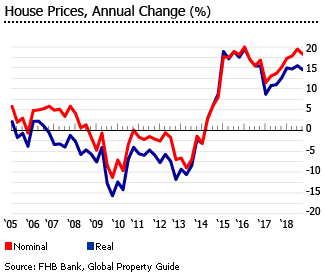
Prices of new dwellings rose by 18.4% y-o-y (14.7% inflation-adjusted) during 2018, while prices of second-hand dwellings went up by 10.8% (7.4% inflation-adjusted), based on figures released by the Hungarian Central Statistical Office (KSH).
Demand continues to rise. The total number of second-hand homes sold rose by 4.7% to 154,599 units in 2018 from a year earlier, the sixth consecutive year of growth, according to KSH. Credits for purchasing second-hand homes surged by 37% y-o-y in 2018, while credits for new homes rose by 27%.
On the supply side, dwelling permits increased slightly by 0.9% to 18,227 units during the first half of 2019 compared to the same period last year. Dwelling completions fell marginally by 0.7% y-o-y to 6,472 units in H1 2019.
The housing market is expected to remain strong this year, amidst robust economic growth. The economy grew by 4.9% in Q2 2019 from a year earlier. The economy is expected to expand by 4.4% this year, its seventh consecutive year of robust growth, based on projections from the European Commission.
Local house price variations
All major regions and cities registered double-digit house price increases during 2018.
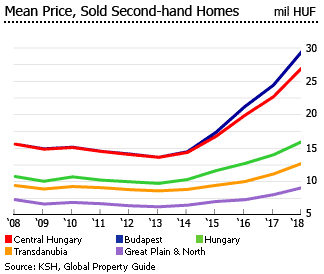
- Budapest, the most expensive housing in Hungary, registered the biggest annual growth of 20.8% during 2018, with the average price of second-hand homes reaching HUF 29.52 million (EUR 88,720).
- In Pest, house prices rose by 15.7% y-o-y to an average of HUF 21.54 million (EUR 64,737).
- In Central Transdanubia, the average house price rose by 16.9% y-o-y to HUF 13.26 million (EUR 39,852).
- In Western Transdanubia, the average house price rose by 13.5% y-o-y to HUF 14.61 million (EUR 43,909).
- In Southern Transdanubia, house prices increased 12.1% y-o-y to HUF 10.36 million (EUR 31,136).
- In Northern Hungary, house prices rose by 11.8% y-o-y to HUF 7.41 million (EUR 22,270).
- In Northern Great Plain, house prices rose by 13.1% to HUF 9.61 million (EUR 28,882).
- In Southern Great Plain, the average house price increased 13.9% to HUF 9.94 million (EUR 29,874).
Demand continues to rise in Hungary, but slowing in Budapest
The total number of second-hand homes sold rose by 4.7% to 154,599 units in 2018 from a year earlier, according to KSH. It was the sixth consecutive year of rising demand, after annual growth of 4.4% in 2017, 8.2% in 2016, 18.3% in 2015, 27.8% in 2014 and 3.7% in 2013.
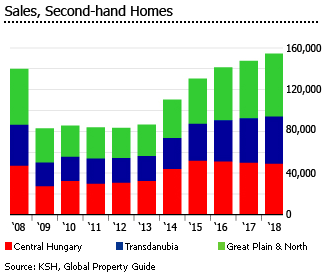
By region:
- In Central Hungary, second-hand home sales fell slightly by 1.9% y-o-y to 48,876 units in 2018. In Budapest, sales fell by 3.5% to 33,510 units in 2018 while sales in Pest rose by 1.6% to 15,366 units.
- In Transdanubia, second-hand home sales were up 6.5% y-o-y to 45,358 units last year.
- In Great Plain and North, sales rose by 9.3% to 60,365 units in 2018 from a year earlier.
Purchases of real estate in Hungary by foreigners
During 2018, foreigners bought about 7,300 residential properties in Hungary, at par with the previous year. While foreign homebuyers made up only about 2.3% of all sales transactions nationwide, they reach 12% in Budapest and 26% in the inner districts of Pest. This is one of the reasons of the huge price difference between the city and the whole country. A foreigner buying a home in Budapest spends on average just above HUF 40 million (EUR 120,220).
Most of the foreign homebuyers in Hungary are Germans, Chinese, Romanians, Vietnamese, French and Israelis, among others.
Hungarian law requires that real estate purchases shall be concluded through private contract (purchase agreement) countersigned by a lawyer. Non-Hungarian citizens must gain the approval of the relevant Administrative Office to purchase property as a private person. Most foreigners should receive a permit within 2-3 months.
Most lawyers advise foreign nationals to set up a company registered in Hungary in order to purchase property. In this case, no permit is needed. This is a fairly swift and easy procedure (taking 1-2 days), and all expenses can be written off.
Property market history
During Hungary’s housing boom (1998-2007), house prices soared by 338% (131% inflation-adjusted). However, the market started to fall in 2008 in the global financial meltdown. House prices fell by 22% (37% inflation-adjusted) from 2008 to 2013.
The housing market started to recover in 2014, with house prices rising by almost 8% (8.7% inflation-adjusted). House prices have been rising annually by double-digit figures since. In fact in the past five years, house prices surged by a total of 107% (94% inflation-adjusted).
HOUSE PRICES, ANNUAL CHANGE (%) |
||
| Year | Nominal | Inflation-adjusted |
| 2008 | -1.73 | -5.73 |
| 2009 | -11.30 | -15.69 |
| 2010 | 0.08 | -4.06 |
| 2011 | -2.09 | -5.94 |
| 2012 | -7.00 | -11.76 |
| 2013 | -1.37 | -2.10 |
| 2014 | 7.99 | 8.74 |
| 2015 | 18.15 | 17.54 |
| 2016 | 16.85 | 15.42 |
| 2017 | 15.14 | 12.55 |
| 2018 | 18.26 | 14.54 |
| Sources: FHB Bank, Global Property Guide | ||
Government measures have boosted the market
Part of the recovery in housing demand during 2014-5 was caused by a series of government measures. First, at the beginning of 2013, the government increased the amount of 5-year loan subsidies, the maximum value of subsidized loans, and the loan house price threshold, causing significantly stronger credit demand in the second half of 2013.
From July 1, 2015 a non-refundable subsidy, the family housing allowance (CSOK) became available. It can be used for buying new- and used homes, for apartment expansions, and for home construction. This subsidy scheme was expanded in March 2018, allowing families returning from abroad and those already owning a property who are about to buy new or resale homes to apply for the CSOK. As of early-2019, more than 100,000 families have already benefited from the said housing program, according to Katalin Novák, the state secretary for youth and family affairs.
In addition, the National Assembly lowered the VAT rate for new dwelling units to 5% in December 15, 2015, sharply down from the previous 27%, in a further attempt to boost the property market. The new VAT rate is effective from 2016 to 2019. The amendment also contained other measures to improve construction sector’s performance and reduce red tape, according to the Ministry for National Economy.
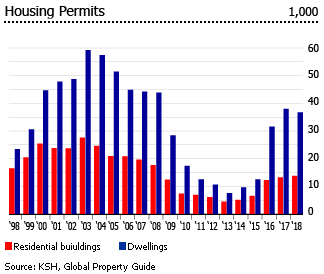
In November 2018, the Parliament approved a proposal to extend the implementation of the 5% VAT rate up to December 31, 2023. Though the said extension would only be applicable to properties with a final building permit obtained by November 1, 2018.
As a result of the surge in demand for new dwellings, residential construction rose sharply. In 2018, the total number of newly built dwellings in Hungary soared 22.9% y-o-y to 17,681 units, following annual rises of 44% in 2017 and 31.3% in 2016, based on KSH figures that were analyzed by Global Property Guide. Almost half of the new supply was located in Budapest and Pest.
Residential construction mixed
During the first half of 2019 dwelling completions fell slightly by 0.7% y-o-y to 6,472 units. Out of Hungary’s three large regions, Central Hungary (which consists of Budapest and Pest county) recorded the biggest decline in new dwellings built, falling by 7.1% y-o-y to 3,039 units in H1 2019, followed by Great Plain and North, with 3.8% drop. In contrast, Transdanubia saw a 10.5% rise in new dwellings built to 2,401 units in H1 2019.
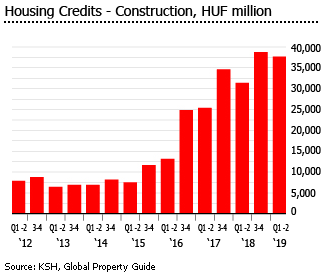
However, completions are expected to increase again in the medium term with the rise in permits. In H1 2019, the total number of permits issued for residential buildings rose strongly by 11.4% y-o-y to 7,486 in H1 2019, based on KSH figures. Dwelling permits also increased slightly by 0.9% to 18,227 units in H1 2019 from the same period last year.
In addition, the total value of housing credits for construction surged 20.2%y-o-y to HUF 37.72 billion (EUR 113.36 million) in the first half of this year.
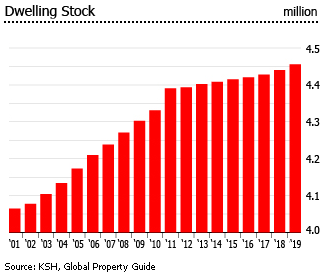
As of early-2019, the total dwelling stock in the country stood at 4,455,491 units, up 0.3% from a year earlier, according to KSH.
Rental yields are good in Budapest
Gross rental yields in Budapest are moderately good. In Buda, Budapest’s greener side, apartments have relatively higher yields ranging from 5.63% for a smaller-sized apartment of 90 sq. m. to 5.73% for a larger apartment of 120 sq. m., based on a Global Property Guide research. Apartments in Pest, Budapest’s business and commercial centre, have slightly lower rental yields ranging from 5.16% to 5.24%.
In Buda, a 120-sq. m. apartment can be rented for EUR1,260 (USD1,389) per month. In Pest, the average monthly rent for a similar apartment was EUR1,320 (USD1,456).
In Budapest, rent movements for apartments are varied. In most districts, rents rose by less than 10% in the first half of 2019 from a year earlier, but in more popular areas such as District 9 and 13, rents actually remained unchanged, according to Otthon Centrum’s Residential Market Monitor Q2 2019. The average monthly rents for brick apartments in Budapest range from HUF2,400 (EUR7.23) to HUF3,600 (EUR10.84) per square meter (sq. m.) in H1 2019. Districts 5 and 13 were the most expensive areas while Districts 15 and 16 were the cheapest.
In other main regional centers such as Debrecen, Győr, Miskolc and Székesfehérvár, rents increased by as much as 20% y-o-y in H1 2019. The average rental price in these areas was HUF2,000 (EUR6) per sq. m. per month.
Low interest rates
Housing loan interest rates remain low. In August 2019, the average interest rate on housing loans was 4.61%, almost unchanged from 4.54% a year earlier and 4.89% two years ago, according to the European Central Bank (ECB).
Average interest rates on loans for house purchases in August 2019:
- Initial rate fixation (IRF) up to 1 year: 5.91%, down from 6.23% a year earlier
- IRF over 1 year and up to 5 years: 5.24%, down from 5.41% a year ago
- IRF over 5 years: 4.59%, slightly up from 4.51% a year ago
More housing is now being bought with loans. From only around one-third (33.5%) in 2015, 46% of housing market transactions were accompanied by a loan by end of 2018, according to MNB’s Housing Market Report – May 2019.
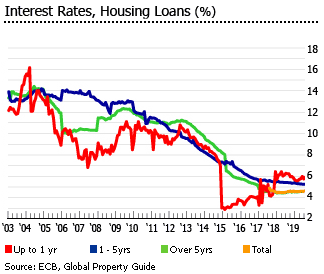
Aside from low interest rates, part of the rising demand for loans is attributable to the popularity of the Family Housing Subsidy Scheme (CSOK). Since its launch in July 2015, about 16% of the total new housing loans, on average, were related to CSOK.
The mortgage crisis is over
Hungary’s residential mortgage market ground to a halt in 2009 as a result of the decline in the value of the Forint against the Euro. A large portion of mortgages were backed by foreign currency loans, burdening homeowners with swelling repayments, and prompting buyers to exit the market.
Foreign currency mortgages were banned in August 2010, and a number of measures were introduced to manage the foreign currency loan crisis:
- an early repayment scheme
- exchange rate fixing
- foreclosure quota
- home protection interest subsidy
- establishment of the National Asset Management Company
The introduction of an early repayment scheme in September 2011 unilaterally changed the terms of all foreign currency loan contracts and allowed debtors to make a one-off repayment of their loans at a discounted exchange rate. Banks had to cover the difference between the discounted exchange rate and the current exchange rate. Those unable to afford early repayment of foreign currency loans have been able to get help since 2012 by paying the installments at a fixed exchange rate.
As of December 2015, only 0.2% of the stock of housing loans was in foreign currency, down from 52% in December 2014. Legislation adopted in November 2014 required financial institutions to convert all outstanding foreign currency-denominated loans into HUF claims.
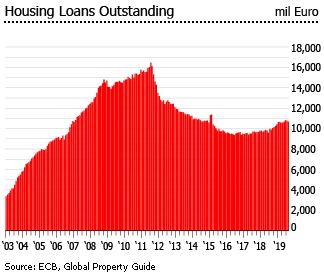
The National Asset Management Inc purchased properties of debtors unable to pay mortgages, allowing debtors to continued use of these properties as tenants. Around 19,628 collateralized properties were purchased from January 2013 to December 2015.
From January 1, 2015 creditors have been allowed to sell any non-performing residential real estate, without restriction - a sign of the end of the crisis.
Currently, around 93% of current loans are "problem free", from 86% to 89% in 2016. About 2.5% were “under special watch” while only 0.4% of the total current loans were “below average”. The remaining 4% were categorized as “sub-prime” (consisting of doubtful and bad loans).
Mortgage market remains steady, despite surging home loans
In 2018, the total value of new housing loans amounted to HUF 850 billion (2.55 billion), up by 31% from the prior year, according to MNB’s Housing Market Report – May 2019.
- Loans borrowed for the purchase of used homes, which constituted almost three-fourths of new housing loans, were up 37% y-o-y in 2018.
- Loans for the purchase or construction of new homes, which accounted for 17% of new loans, rose by 27% y-o-y in 2018.
As a result, the total value of housing loans outstanding increased 10.3% to HUF 3.22 trillion (EUR 9.69 billion) in 2018 from a year earlier, according to KSH’s Residential Mortgages in 2018 report.
Despite this, the size of the mortgage market remained at 7.9% of GDP in 2018, almost unchanged from a year earlier, according to KSH.
Strong economic growth continues in Hungary
Hungary’s economic growth has been robust for the last six years, and this year won’t be an exemption. Hungary’s GDP rose by 4.9% in 2018, up from a 4.1% expansion in 2017 and the highest growth since 2004.
The economy grew by 4.9% in Q2 2019 from a year earlier, following expansions of 5.3% in Q1 2019, 5.1% in both Q3 and Q4 2018, and 4.9% in Q2 2018, according to KSH. Services, construction and industry contributed mostly to the country’s strong Q2 2019 performance.
The economy is expected to expand by 4.4% this year, based on projections from the European Commission.
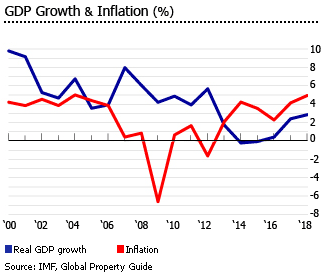
In August 2019, nationwide unemployment rate stood at 3.4%, down from 3.7% a year earlier, according to KSH figures. Jobless rate fell to an average of 4.3% in 2016-18, from an average of 8% from 2000-15.
The country’s inflation slowed to 2.8% y-o-y in September 2019 from 3.6% a year earlier – still in line with the central bank’s 3% plus or minus 1.0 percentage point inflation target.
Is Orban’s star waning?
Since coming to power in 2010, Hungary's nationalist prime minister Victor Orbán has concentrated power and media organs in his hands, and regularly clashes with Brussels over migration and rule-of-law issues. Strong economic growth since the crisis has boosted his popularity, propelling him and his party, Fidesz (the Hungarian Civic Union) to victory in the 2014 elections, and again in the 2018 national elections, with a two-thirds majority. The Fidesz–KDNP alliance won a two-thirds majority, with 133 seats out of 199.
However in an extraordinary turnaround in October 2019 the opposition beat Orban's candidate for Budapest mayor, and won 10 of 23 of Hungary’s main cities. The impetus was widespread urban discontent, and a strategy of alliance among opposition parties to enable them to present single candidates.
Orban’s growing authoritarianism has in fact been meeting rising resistance. In a move towards the creation of an "illiberal" state, in April 2017 the Hungarian Parliament imposed stringent restrictions on foreign universities, a move primarily directed towards the Central European University (CEU), founded by philanthropist and Hungarian NGO supporter George Soros. Forbidden to accept new students after January 1 2019, the CEU re-launched all U.S. accredited degrees in Vienna from September 2019.
In May 2017, large anti-corruption street protests occurred in Budapest, expressing support for CEU and NGOs. During the same month, two United Nations Special Rapporteurs also expressed their objection against the Hungarian government’s draft "Bill on the Transparency of Organisations Financed from Abroad" that would limit NGO activities. The bill was eventually passed as law in June 2017.
The victory in Budapest of pro-European centre-left challenger Gergely Karácsony, backed by a wide range of opposition parties from across the political spectrum, bears resemblance to the June 2019 victory of opposition candidate Ekrem Imamoglu in Istanbul. Maybe people eventually tire of authoritarian rulers, if given a choice.
Sources:
- Housing price indices (Hungarian Central Statistical Office): http://www.ksh.hu/docs/eng/xstadat/xstadat_infra/e_zrs006.html
- Takarek Lakasarindex 2018. IV. Negyedev (Takarek Index): http://www.takarekindex.hu/Root/Sites/FHB_Index/FHB-Index/Letoltheto-anyagok/Takarek_lakasar_index_Q4_1.1.pdf
- Residential Market Monitor 2019/Q2 (Otthon Centrum): http://www.property.hu/download/OC_RMM_2019_Q2.pdf
- Housing Market Report – May 2019 (Magyar Nemzeti Bank): https://www.mnb.hu/letoltes/lakaspiaci-jelentes-2019-majus-en-honlapra.pdf
- Are foreigners buying all the Hungarian real estate? (Daily News Hungary): https://dailynewshungary.com/unbelievable-foreigners-are-buying-all-the-hungarian-real-estate/
- 12% of the Budapest Property Buyers were Foreigners in 2018 (My Budapest Home): https://www.mybudapesthome.com/article/12-of-the-budapest-property-buyers-were-foreigners-in-2018-778
- World Economic Outlook Database (International Monetary Fund): https://www.imf.org/external/pubs/ft/weo/2019/01/weodata/index.aspx
- Gross rental yields acceptable in Budapest (Global Property Guide): https://www.globalpropertyguide.com/Europe/Hungary/Rental-Yields
- Money, credit and banking (European Central Bank): https://sdw.ecb.europa.eu/browse.do?node=9691106
- Financial markets and interest rates (European Central Bank): https://sdw.ecb.europa.eu/browse.do?node=9691099
- CSOK home subsidy scheme expands in March (Budapest Business Journal): https://bbj.hu/economy/csok-home-subsidy-scheme-expands-in-march-_146152
- More than 100,000 Families Avail of CSOK Home Purchase Subsidies (Hungary Today): https://hungarytoday.hu/more-than-100000-families-avail-of-csok-home-purchase-subsidies/
- Recently adopted lower VAT rate on newly-built homes to ignite the property market (Ministry of Finance): https://www.kormany.hu/en/ministry-for-national-economy/hungarian-outlook/recently-adopted-lower-vat-rate-on-newly-built-homes-to-ignite-the-property-market
- Hungary: The 5% Vat Rate After 31 December 2019 (Mondaq): http://www.mondaq.com/x/759042/tax+authorities/The+5+Vat+Rate+After+31+December+2019
- Residential mortgages in 2018 (Hungarian Central Statistical Office): http://www.ksh.hu/docs/eng/xftp/stattukor/lakashitel/elakashitel1812.pdf
- Economic forecast for Hungary (European Commission): https://ec.europa.eu/info/business-economy-euro/economic-performance-and-forecasts/economic-performance-country/hungary/economic-forecast-hungary_en
- Unemployment rate was 3.4% (Hungarian Central Statistical Office): http://www.ksh.hu/gyorstajekoztatok/#/en/document/mun1908
- GDP rises by 4.9% (Hungarian Central Statistical Office): http://www.ksh.hu/gyorstajekoztatok/#/en/document/gdp1906
- MEPs vote to pursue action against Hungary over Orbán crackdown (The Guardian): https://www.theguardian.com/world/2018/sep/12/eu-meps-vote-to-pursue-action-against-hungary-over-orban-crackdown
- Hungary's 'Stop Soros' law makes it illegal to help migrants (CNN): https://edition.cnn.com/2018/06/20/europe/hungary-law-immigrants-crackdown-intl/index.html